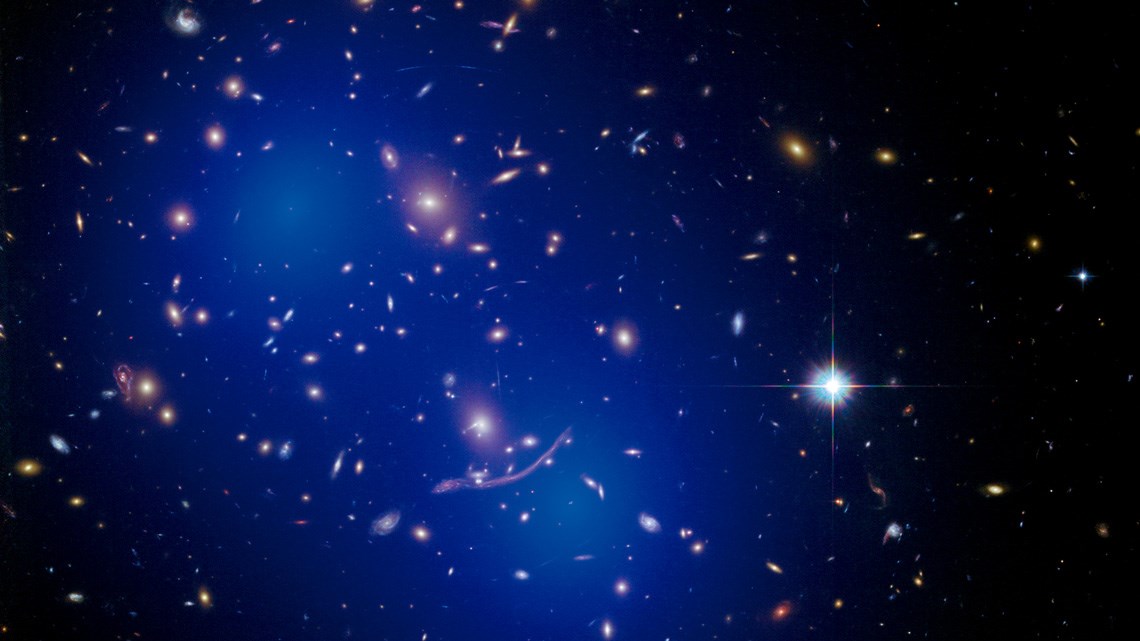Unprecedented data obtained from CERN’s Large Hadron Collider (LHC), have provided an important clue in the search for the origins of dark matter, which makes up 85% of all matter in the Universe, but whose nature is yet unknown. The ALICE experiment, one of four major projects being run at the world’s largest particle accelerator, located near Geneva, Switzerland, has produced evidence that light antihelium nuclei, also called helium antinuclei, can travel long distances within the Milky Way. The scientists have also determined the frequency with which this type of antimatter would reach the Earth’s vicinity. According to a study published in early December by members of the ALICE research team in the scientific journal Nature Physics, half of these antihelium nuclei originating from processes associated with the presence of dark matter can cross the galaxy without being destroyed.
The data indicate that this very rare type of antimatter could be used in space as a tracer for the genesis of dark matter, one of the biggest mysteries in cosmology. “Our findings demonstrate that searches for light antimatter nuclei from outer space remain a powerful way to hunt for dark matter,” says Italian physicist Luciano Musa, spokesperson for the CERN (European Organization for Nuclear Research) experiment, an international collaboration that brings together 2,000 researchers from 40 countries, including Brazil. Instruments such as the Alpha Magnetic spectrometer installed on the International Space Station, or observation balloons, would in theory be able to measure light antimatter nuclei and better map the presence of dark matter as a consequence. “The article is a multidisciplinary work, which brought together particle physics and cosmology, with both experimental and theoretical researchers,” comments physicist David Chinellato, from the University of Campinas (UNICAMP), a member of the ALICE experiment team who is spending two years at the LHC and is one of the study’s authors.
According to physics theory, antimatter is generated simultaneously with matter, which it is identical to in certain aspects, such as mass and energy, however, antimatter’s electrical charge and certain quantum parameters have opposite values. The electron, for example, is a particle with a negative charge. Its partner, the positron or antielectron, is positive (this antiparticle is used in positron emission tomography, in the exam known as PET). When a particle collides with its respective antiparticle, they annihilate each other and produce energy. It would be expected that the same amount of matter and antimatter should exist in the Universe. However, for reasons mostly unknown, there is an almost complete predominance of matter over antimatter, which makes the cosmos a lethally inhospitable environment for antiparticles. The novel accomplishment of the LHC study is to show that antihelium nuclei survive much longer than previously thought possible.

Nasa/ESA/ D. Harvey/R. Massey/ Hubble SM4 ERO Team/ST-ECFImage of the galaxy cluster Abell 370 with a projected estimate of dark matter in its surroundings (bluish area)Nasa/ESA/ D. Harvey/R. Massey/ Hubble SM4 ERO Team/ST-ECF
Two processes are associated with the production of light antimatter nuclei. The first is high-energy collisions between cosmic rays and the interstellar medium, the space between the stars of a galaxy, which, despite appearing empty does contain some matter, especially hydrogen. The second would be the weak interaction between components of particles of the elusive dark matter. “The role of cosmic rays in the generation of antimatter is documented. That of dark matter is still a hypothesis, predicted by several models,” comments experimental physicist Mauro Cosentino, from the Federal University of ABC (UFABC), another member of the Brazilian ALICE team and one of the study’s coauthors. “But, a priori, it is not possible to know which of the two processes generated a random antimatter nucleus detected in space. What our study does is provide a parameter that could be useful for discriminating which mechanism produced that antinucleus.”
Survival rate
The ALICE researchers analyzed the results from collisions of elemental lead protons and nuclei accelerated at the LHC. The shocks generated nuclei of an isotope (a form) of the antiparticle of helium, antihelium-3, composed of two antiprotons and an antineutron. This form of antimatter interacts with the matter making up the experiment’s detectors. In this process, one group of these antinuclei disappears and another part remains. Roughly speaking, the detectors register how many antihelium nuclei were produced by the initial collisions of lead protons and nuclei and how many were left after the antimatter interacted with the matter of the detector itself. In this way, the physicists determined the survival rate of antihelium nuclei under these conditions. Then, employing computational models, they used this value to simulate what the probability should be for light helium-3 antinuclei created in the Milky Way to cross the galaxy without being destroyed and reach the vicinity of Earth.
For antinuclei derived from the interaction with dark matter, half of the antiparticles would reach our planet. In the case of antinuclei originating from the contact of cosmic rays with the interstellar medium, between 25% and 90% of the antiparticles would have the capacity to survive and cross the Milky Way. Although the numbers generated by the two processes may coincide if the survival rate is around 50%, the antimatter from cosmic rays would have higher energies than those from dark matter interactions. “This difference would make it possible to distinguish which is the source of the helium antinuclei,” explains Chinellato. “Thus, we would have an energy signature of the origin of the antimatter.”
Less than 15% of the matter in the Universe is composed of baryonic, “normal” matter, which forms the galaxies, stars, and planets detectable at some wavelength. The remainder is formed by a type of invisible matter, called dark matter, which does not reflect, absorb, or emit light. It is not known what dark matter is made of. Its existence is only indirectly determined by its enormous gravitational effect on the Universe.
Scientific article
The ALICE Collaboration. Measurement of anti-3 He nuclei absorption in matter and impact on their propagation in the Galaxy. Nature Physics. Dec. 12, 2022.


